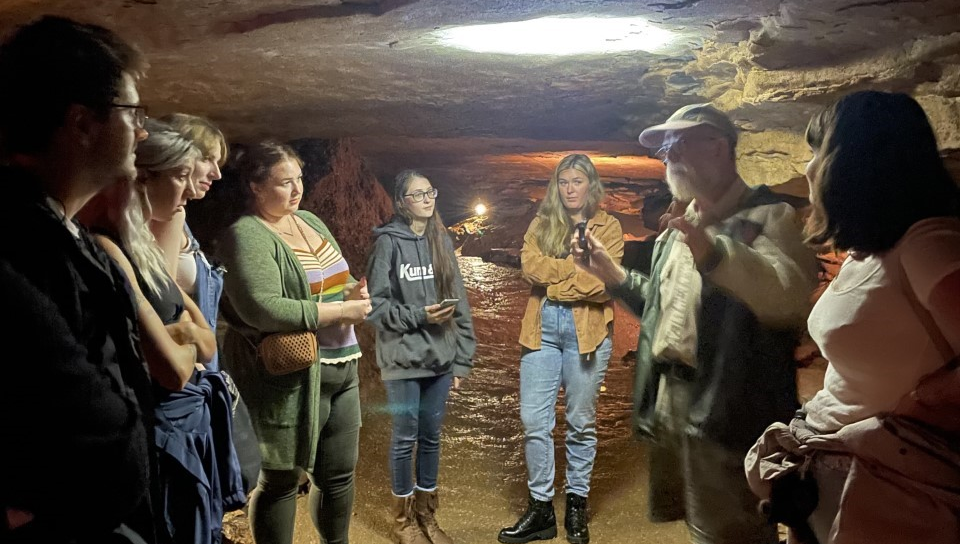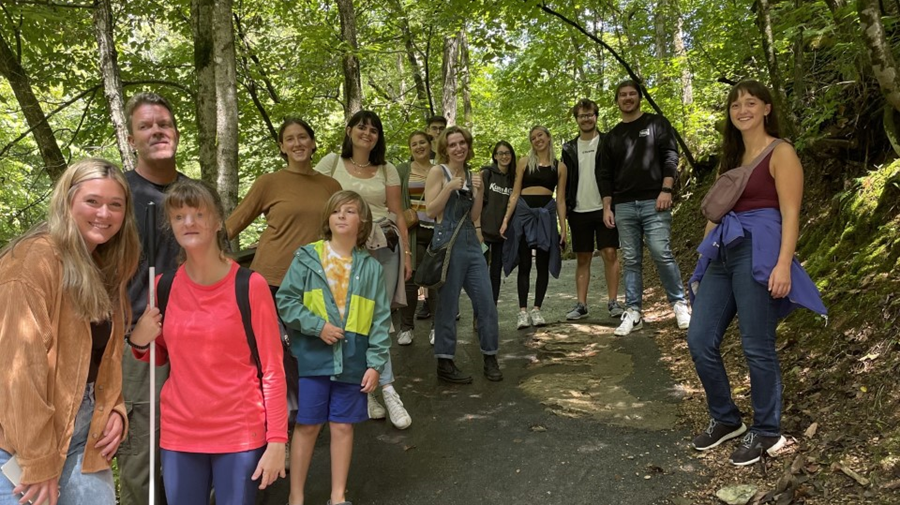Oct. 05, 2022
This past August intersession, the undergraduate and graduate students enrolled in Bryan Hurt's "Pit Lit" course (ENGL 4603/5243) dove deep into the course topic, literally. They had the opportunity to consider the course materials within the classroom as well as beneath the surface of the earth.
Hurt, a professor for the Program in Creative Writing and Translation in the Department of English, came up with the idea for the course while reading, back-to-back, Haruki Murakami's The Wind-Up Bird Chronicles and Kōbō Abe's The Woman in the Dunes.
"I had the somewhat superficial realization that there were a lot of books about people who descend into holes and get stuck in them," he said. "Once I saw this theme, I couldn't stop seeing it. Pit books were everywhere. In contemporary literature. Classical. I thought it would be fun to build a class that explored the idea more closely."
When subsequently assembling his course syllabus, Hurt selected centuries-old literature along with books released just a few years ago, both poetry and prose, and films as well as written texts.
"[The course] began with Alice in Wonderland, which I thought of as a sort of canonical text (Carroll originally titled his manuscript Alice's Adventures Under Ground). We watched [film director] Werner Herzog's Cave of Forgotten Dreams, which is in many ways about the intersection of art and caves," Hurt explained.
"After we established a shared vocabulary of themes and ideas that we expected to see in works of 'Pit Lit,' we opened up and read a little more broadly to verify or challenge those ideas. Since it was just a 10-day course, I wanted to stick to relatively short novels, 200 pages or less."
.png) |
| Hurt teaching "Pit Lit" on the U of A campus. |
Hurt also assigned Abe's The Woman in the Dunes, Helen Phillips's The Need, Hiroko Oyamada's The Hole and Davis McCombs's first book of poetry, Ultima Thule.
"I think we all agreed that, by the end of the course, we'd just scratched the surface of pit books to read," Hurt said.
But discussing the assigned materials while sitting in a classroom was not all Hurt had in mind for getting his students excited about taking the course.
"Since there are so many good caves in Northwest Arkansas," he noted, "I thought it'd be worth our while to visit one."
Having the class convene one day at War Eagle Cavern, in Benton County, turned out to be an effective exercise for a course focusing on underground literature. "I remember the guide telling us at one point that there was several hundred feet of pure rock sitting on top of us," Hurt said. "The feeling was uncomfortable and uncanny, which I think is a feeling that a lot of pit books try to capture."
Even though the length of the August intersession allowed the class only enough time to begin exploring the "Pit Lit" genre, Hurt found the shorter schedule beneficial.
"I like teaching intersession courses because they give me a chance to experiment and test out new ideas. I was thrilled that all of the students met the course with enthusiasm, curiosity and ultimately, a real sense of engagement with the subject," he said.
"The students are always the best part of teaching, and this class was no exception."
The students likewise appreciated Hurt's teaching a literature course quite different from any previously offered by the English Department.
"I thoroughly enjoyed learning about how underground spaces function in literature, both physically and metaphorically, in Dr. Hurt's course," M.F.A. student Sophie Trist responded. "The trip to War Eagle Caverns was an amazing way to start the course because it gave us an opportunity to actually experience the ambiance of the type of space we were studying. There's so much fascinating material in the 'Pit Lit' subgenre that I wish we could've continued our survey for an entire semester."
According to B.A. student Sarah Davis, Hurt's course guided her to discover more in her reading by using fresh tools of literary excavation. "This course provided me with an insight into literature that I otherwise would not have even begun to look for in my readings. It left me filled with new ways to dig deeper into what a story's connection can really be to and why."
 |
| "Pit Lit" students with a guide inside War Eagle Cavern. |
The diversity of materials that class members studied and the range of underground spaces they discussed, combined with the trip to War Eagle Cavern and Hurt's innovative approach to pedagogy, are what stood out to Ph.D. student Scott Hendry.
"After experiencing Dr. Hurt's immersive deep-dive into 'underground' art, an often-utilized yet seldom analyzed genre, I can say unreservedly that the 'Pit Lit' course is fantastic! Through readings and interpretations of new novels, foreign films, regional poetry and classic works of literature, we explored pits, caves, tunnels, holes and subterranean existence in ways that were innovative and enlightening. Our visit to an actual cave helped set the tone for a powerful, multi-layered study. I learned so much, and I appreciate Dr. Hurt's invitational style of teaching. I wholeheartedly recommend the course."
There is a possibility that Hurt will teach the course again next August intersession. However, he is now at Cambridge University on fellowship, and his not knowing exactly when he will get back means he can't make any promises.
But his return to offering "Pit Lit" at some point is pretty certain.
"I definitely want to teach the class again," he said. "I could even imagine doing it as a full semester-long course in the future."
"course" - Google News
October 05, 2022 at 12:02PM
https://ift.tt/qCHnYaZ
"Pit Lit" Course Takes Students Deep into Literature and a Local Cave | University of Arkansas - University of Arkansas Newswire
"course" - Google News
https://ift.tt/aOTgPs5
https://ift.tt/yl4eWg7
Bagikan Berita Ini















0 Response to ""Pit Lit" Course Takes Students Deep into Literature and a Local Cave | University of Arkansas - University of Arkansas Newswire"
Post a Comment